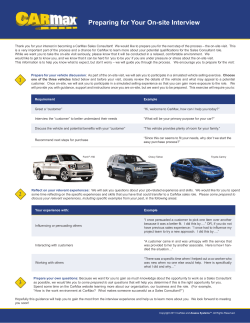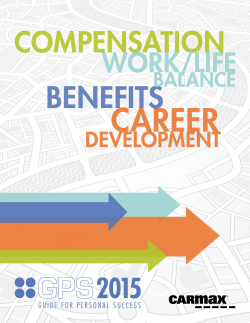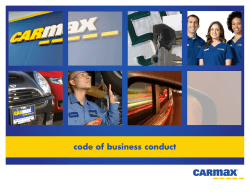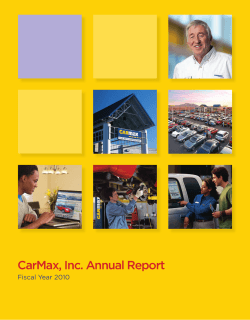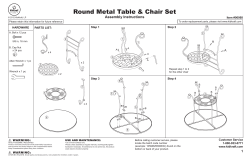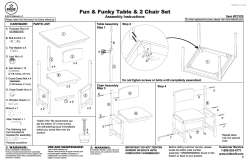
CarMax, Inc. History (0-9)
4/25/13 History of CarMax, Inc. – FundingUniverse Browse Company Profiles: (0-9) A B C D E F G H I J K L M N O P Q R S T U V W X Y Z CarMax, Inc. History Official Malibu Site www.Chevrolet.com/Malibu Read The Latest Articles For More Information On The Chevy Malibu ► Current Offers ► Locate A Dealer Advertise Here Address: 4900 Cox Road Glen Allen, Virginia 23060 U.S.A. Telephone: (804) 747-0422 Toll Free: 800-922-7829 Fax: (804) 747-5848 Public Company Incorporated: 1993 as CarMax Group Employees: 5,910 Sales: $3.2 billion (2002) Stock Exchanges: New York Ticker Symbol: KMX NAIC: 441120 Used Car Dealers Website: www.carmax.com Advertise Here Share This Page 0 Tw eet 0 CarMax's operating strategy is to build customer confidence and satisfaction by offering high-quality vehicles; therefore, fewer than half of the vehicles acquired through the appraisal process meet CarMax standards for reconditioning and subsequent retail sale. Key Dates: Like 0 Share Company Perspectives: 1993: 1996: 1997: 1999: 2002: The first CarMax used car lot opens in Richmond, Virginia. CarMax acquires its first new car franchise. A portion of CarMax is sold to the public. CarMax records its first annual profit. CarMax is spun off from Circuit City Stores. Company History: CarMax, Inc. operates a chain of used car lots and new car franchises. CarMax's used car lots are patterned after the massmerchandising business model of its former parent company, Circuit City Stores, Inc., operating as "superstores." The company's stores typically contain roughly 500 used cars no more than six model years old. The prices of the vehicles are fixed in an effort to create a more relaxed sales atmosphere. CarMax operates 37 used car superstores and 17 new car franchises. Origins www.fundinguniverse.com/company-histories/carmax-inc-history/ 1/4 4/25/13 History of CarMax, Inc. – FundingUniverse CarMax, industry observers noted at the time of its inception, triggered a revolution in used car retailing, sending tremors of fear among the legions of traditional, small-sized dealers and establishing a new business model that was quickly aped by others. The creation of the concept was the work of Richard Sharp and W. Austin Ligon. The corporate entity behind the formation of CarMax was Circuit City Stores, Inc. A 375-store, consumer electronics chain with $7 billion in sales during the early 1990s, Circuit City was led by Sharp. Ligon worked under Sharp, serving as Circuit City's senior vice-president of corporate planning. Together, the pair developed the CarMax concept, a business approach that drew its inspiration from the sprawling Circuit City chain and its "big-box" retail concept. The story of CarMax's development began with a survey conducted in 1991. "We asked people who bought used and new cars about their shopping experience," Sharp explained in an October 23, 1995 interview with Forbes. "Not surprisingly, there were more dislikes than likes." Sharp looked at the $150 billion used car market and saw three qualities that convinced him the Circuit City approach to retailing could be grafted onto the used car market: first, the supply of used cars was abundant; second, the demand for used cars was consistent; and finally--perhaps most importantly--the management practices employed within the fragmented industry were unsophisticated. For two years, Sharp and Ligon worked on fine-tuning their concept, devoting much of their time to developing a process to monitor inventory and pricing. The two Circuit City executives concentrated on ways to determine precisely which make, model, and color of vehicles to stock on their proposed chain of lots, and when and how much to adjust prices. The strategy, like that of a Circuit City store, centered on a broad selection of merchandise, a high-volume business, economies of scale, and sharply honed management methods. "We can apply our expertise in electronics retailing to auto retailing," Sharp informed Discount Store News in a November 6, 1996 interview. Sharp and Ligon were ready by 1993 to put their theories to the test. Using money from Circuit City to finance the startup, Sharp and Ligon opened their first superstore, a lot operating under the banner "CarMax: The Auto Superstore," in October 1993. The showroom, located in Richmond, Virginia, represented the first unit of the newly created CarMax Group, a wholly owned subsidiary of Circuit City. The Richmond lot served as the prototype of the other used car superstores that would follow in its wake: 500 cars were on display, each no more than five model years old, and each with no more than 70,000 miles on its odometer. Inside, the Richmond CarMax contained a service shop and salespeople offering a refreshing approach to used car sales. Prices on the vehicles were fixed, obviating the need for customers to negotiate the price of a prospective purchase. CarMax's "no-haggling" policy and the less adversarial atmosphere it created between salespeople and customers was complemented by computer kiosks delineating the lot's inventory and particular details about each vehicle. As Sharp and Ligon pressed forward with their plan of applying the superstore concept to used car retailing, they knew the road ahead would be difficult. Neither executive anticipated the enterprise would generate a profit for several years--perhaps taking as long as the end of the 1990s. In the interim, substantial sums of money would need to be spent to establish a network of CarMax superstores and to bring the company to the point of critical mass where economies of scale and its sophisticated management practices would give the concept the advantages of a retail superstore. At the time Sharp and Ligon set out, the United States contained 42,000 used car dealers and 22,000 new car dealers who sold used cars received as trade-ins. Among this field, the average used car dealer generated $2 million a year, a total deemed too small to achieve economies of scale or to apply modern management methods. By October 1995, two years after the first CarMax opened, the company had yet to generate a profit, recording $77 million in sales for the previous fiscal year. New superstore openings had lifted CarMax's unit count to four lots, with two superstores in Atlanta and one in Raleigh, North Carolina, having joined the fold. A fifth lot was expected to open in Charlotte, North Carolina, in early 1996, but Sharp had yet to decide whether to turn CarMax into a national chain. A final decision was expected to be made within 18 months on the matter of going national. As CarMax pressed forward during the critical phase of its development, the company's progress was defined by escalating sales and mounting losses. By the end of the company's 1995 fiscal year, sales had increased substantially, soaring from $77 million to $304 million, which exceeded analysts' estimates of between $200 million and $278 million. CarMax's robust sales growth was pocked by a $7 million loss for the year, however, perpetuating speculation that the mass-merchandising approach to used car sales was not a sound business model. Few industry observers doubted whether CarMax could sell cars, but many pundits doubted whether the company could sell cars profitably. The one glaring problem with the chain, according to the business press, was its inability to secure volume discounts on the purchase of its used cars, an ability intrinsic to the success of the Circuit City chain. CarMax purchased its vehicles at the same auctions attended by independent dealers and paid roughly the same price an independent dealer paid. Without the benefits of volume purchasing, CarMax faced a difficult road to profitability. The solution to CarMax's cashflow problem, as proposed by Sharp and Ligon, was the physical expansion of the chain. The company opened its fifth and sixth lots in 1996 and announced ambitious expansion plans. In 1997, Sharp and Ligon planned to open between 8 and 10 lots, with new openings of between 15 and 20 stores for each year thereafter. The markets slated for expansion included Miami, Tampa, Dallas, Houston, Washington, D.C., Baltimore, Chicago, Los Angeles, San Francisco, and Tidewater, Virginia. The company projected an 80- to 90-unit chain by 2001. By the mid-1990s, CarMax's expansion strategy included a new facet to the company's business. The company acquired its first new car franchise in 1996, a Chrysler-Plymouth-Jeep store located in Atlanta. Looking ahead, CarMax planned to open between 15 and 25 new car dealerships by 2002, stores that were to operate alongside the company's used car dealerships. Late 1990s Expansion www.fundinguniverse.com/company-histories/carmax-inc-history/ 2/4 4/25/13 History of CarMax, Inc. – FundingUniverse The financial constraints of expanding in the face of persistent losses presented formidable obstacles to Sharp and Ligon. Although Circuit City had contributed to CarMax's startup, the company's financial assistance to CarMax essentially ended there. The arrangement kept Circuit City's financial health from being drained by CarMax's costly expansion program, forcing Sharp and Ligon to find other ways to secure capital. At the end of 1996, the pair proposed a new method of securing financing, announcing that Circuit City would sell a portion of the CarMax subsidiary to the public. The initial proposal called for offering between 15 and 20 percent of CarMax to the public, a stake that was expected to raise as much as $300 million. The offering was completed in February 1997, providing CarMax with fresh resources to finance its expansion and to repay its rising debt. The proceeds gained from CarMax's public offering enabled the company to accelerate its expansion program. At the time of the offering, the company had seven superstores in operation, which generated nearly $450 million in revenues. By mid-1998, there were 23 superstores in operation, enabling the company to record $1.47 billion in sales for fiscal 1998. Despite the impressive gain in sales, the company continued to be hobbled by annual losses. CarMax lost $23.5 million in fiscal 1998, enough of a loss to prompt Sharp and Ligon to scale back expansion plans for 1999. Instead of opening between 15 and 20 stores in 1999, as originally planned, the company announced it would open 10 stores that year. By the end of the decade, CarMax was nearing the moment of truth. "We've had to learn as we go along," Ligon explained in a July 12, 1999 interview with Automotive News. "We're going to hit about $2 billion in sales this year, which is about the critical mass we need to get to make a profit." Roughly six months later, when the financial results for fiscal 2000 were announced, something unprecedented in the history of CarMax occurred. For the year, the company generated $2.01 billion in revenues and a profit of $1.1 million, the first time CarMax ended a fiscal year in the black. The profit total was meager, but it suggested there was financial viability in the "big box" used car retailing concept. CarMax's progress in the coming years underscored the success of 2000, prompting critics to alter their assessment of the company's business strategy. Profits and Independence in the 21st Century Buoyed by the first annual profit in the company's history, Ligon focused on plans for the future. A national rollout of CarMax superstores remained the company's long-term objective, a goal that was expected to require between 20 and 25 years to achieve. "You can't do it any faster than that," Ligon informed Automotive News in a July 10, 2000 interview. More immediate plans called for a measured pace of expansion, as the company sought to add to the 40 new car franchises and used car superstores in operation at the beginning of the century. Despite the eventual goal of national expansion, initially the company planned to open new locations in markets where it already maintained a presence, focusing on markets with populations ranging between one and two million residents. As CarMax's 10th anniversary approached, the company's financial results provided cause for celebration. In fiscal 2001, sales leaped to $2.5 billion, but the most impressive gain was achieved in CarMax's profit total, which by far eclipsed the symbolic $1.1 million recorded in 2000. Ligon expected to post between $40 million and $43 million in net income in 2001, but the company did better, posting $45.6 million in profits. In 2002, the results were equally as sanguine, as revenues swelled 28 percent to $3.2 billion and net income nearly doubled, jumping to $90.8 million. Against the backdrop of vigorous financial growth, a new era at CarMax began. In the spring of 2002, Circuit City announced it intended to spin off its CarMax subsidiary into a separate, publicly traded company, part of the consumer electronics chain's plan to focus on its core business. The spinoff, completed in October 2002, created CarMax Inc., a corporate entity distinct from Circuit City with Ligon serving as its chief executive officer, a title he gained at the time of the spinoff. As CarMax prepared for its second decade of business, expectations for further financial growth were high. Ligon anticipated opening between six and eight used car superstores per year through 2005, building on the 37 used car superstores and 17 new car franchises already in operation. Principal Subsidiaries: CarMax Auto Finance. Principal Competitors: AutoNation, Inc.; Hendrick Automotive Group; United Auto Group, Inc. Further Reading: "Circuit City to Spin Off CarMax, Chain Will Focus on Electronics," Chain Store Age Executive Fax, March 1, 2002, p. 1. Gilligan, Gregory J., "Circuit City's CarMax Superstores Pass $300 Million in Yearly Sales," Knight Ridder/Tribune Business News, April 5, 1996. ------, "Circuit City Stores to Sell Stake in CarMax Used-Car Chain," Knight Ridder/Tribune Business News, November 14, 1996. Heller, Laura, "Circuit City Restructures, Spins Off CarMax Unit," DSN Retailing Today, March 11, 2002, p. 3. McLean, Bethany, "Squeaky Wheels," Fortune, March 17, 1997, p. 202. Rubinstein, Ed, "Sharp Touts Potential of CarMax," Discount Store News, November 4, 1996, p. 6. Rudnitsky, Howard, "Would You Buy a Used Car from This Man?," Forbes, October 23, 1995, p. 52. Sawyers, Arlena, "CarMax Doubles Profit, Plans More Stores," Automotive News, April 8, 2002, p. 16. ------, "CarMax Says It's Prepared to Fly Solo," Automotive News, November 4, 2002, p. 17. ------, "CarMax's Ligon: Shoppers Are Happy, Profits Are Near," Automotive News, July 12, 1999, p. 32. ------, "CarMax Speeds into Expansion Fast Lane," Automotive News, January 15, 2001, p. 69. www.fundinguniverse.com/company-histories/carmax-inc-history/ 3/4 4/25/13 History of CarMax, Inc. – FundingUniverse ------, "Slowdown Doesn't Faze CarMax," Automotive News, March 12, 2001, p. 8. ------, "Though in the Black, CarMax Has No Expansion Plans," Automotive News, July 10, 2000, p. 34. Wernle, Bradford, "CarMax Sees Red, Slows Expansion Plans," Automotive News, June 15, 1998, p. 6. ------, "CarMax's Strategy: Make Do with Lower Margins," Automotive News, December 2, 1996, p. 52. Advertise Here Source: International Directory of Company Histories, Vol. 55. St. James Press, 2003. Offer Aflac® To Employees www.aflac.com/Business Improve Retention, Productivity and Engagement. Learn More at Aflac. ALSO ON FUNDINGUNIVERSE AROUND THE WEB Publisher (Marketing Focused) Business Plan A Peek Into the Office of a $270 Million Startup 5 months ago AMEX Open Forum Display Technology Company Business Plan VIDEO: Haley is back, this time with clothes on. Watch Burning Love now Yahoo 5 months ago Magazine Publisher Business Plan Pizzeria Franchise Business Plan 5 months ago 5 months ago What's this? How to Unlock a Secured WiFi Connection eHow Ranking 15 Potential College Basketball Cinderellas of The 2013 NCAA … Rant Sports 0 comments 0 Leave a message... Best Share Community No one has commented yet. C o m m e n t fe e d Su b s cri b e vi a e m a i l Terms of Service www.fundinguniverse.com/company-histories/carmax-inc-history/ Privacy Policy Licenses Contact Us Advertise 4/4
© Copyright 2025
